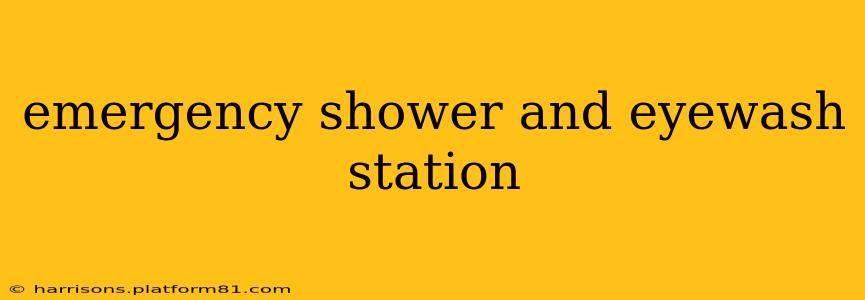Emergency showers and eyewash stations are critical safety equipment in workplaces handling hazardous materials. They provide immediate first aid in case of chemical splashes or exposures to the eyes or body. This comprehensive guide will delve into the importance, regulations, selection, and maintenance of these life-saving devices.
What is an Emergency Shower and Eyewash Station?
An emergency shower and eyewash station is a combined safety unit designed to quickly flush contaminants from a person's eyes, face, and body. The eyewash component typically consists of dual nozzles providing a gentle, continuous flow of water to rinse the eyes thoroughly. The shower component provides a wider spray to cleanse larger areas of the body. These stations are essential in industries where employees handle chemicals, corrosive substances, or other hazardous materials.
Why are Emergency Shower and Eyewash Stations Necessary?
The immediate and thorough rinsing provided by these stations can significantly reduce the severity of injuries from chemical exposure. Prompt action is crucial in minimizing the damage caused by corrosive or irritant substances. Delaying treatment can lead to permanent eye damage, severe burns, or other serious health consequences. Therefore, readily accessible and properly maintained emergency showers and eyewash stations are a matter of workplace safety and legal compliance.
What are the Regulations Surrounding Emergency Shower and Eyewash Stations?
Regulations regarding emergency showers and eyewash stations vary by location and industry, but several common standards exist. Organizations like OSHA (Occupational Safety and Health Administration) in the US and similar agencies in other countries provide detailed guidelines on placement, accessibility, testing, and maintenance requirements. These regulations often mandate the availability of these stations within a specific distance of hazardous material handling areas, ensuring swift access in emergency situations. Failure to comply with these regulations can result in significant penalties.
How far should an emergency shower be from a hazard?
OSHA guidelines recommend that emergency showers be located within 10 seconds of travel from any potential hazard. This means an employee should be able to reach the shower and begin rinsing within 10 seconds of an incident occurring. This timeframe is crucial to effectively mitigate the damage from hazardous materials. The actual distance will vary depending on the layout of the facility and the nature of the hazards present.
What type of water is used in an emergency shower?
Emergency showers and eyewash stations should ideally use potable water, meaning water that is safe for drinking. However, some situations may allow for non-potable water if it meets specific purity standards and is clearly labeled as such. The water must be free of contaminants that could exacerbate the injury and should be delivered at a comfortable temperature—not too hot or too cold.
How often should emergency showers and eyewash stations be inspected and tested?
Regular inspection and testing are critical to ensure the functionality of emergency showers and eyewash stations. Many jurisdictions mandate monthly inspections and annual testing, which involves checking water flow rate, pressure, and nozzle function. Documentation of these inspections and tests is essential for compliance and safety audits. Any defects discovered should be addressed immediately.
How do I choose the right emergency shower and eyewwash station for my needs?
Selecting the appropriate emergency shower and eyewash station involves considering several factors, including the type and quantity of hazardous materials handled, the number of employees, the layout of the facility, and the applicable regulations. Factors such as the station's material (e.g., stainless steel for chemical resistance), plumbed versus self-contained units, and the availability of additional features like temperature control should also be considered.
Maintenance of Emergency Shower and Eyewash Stations
Regular maintenance is paramount to the effectiveness of emergency showers and eyewash stations. This includes:
- Visual Inspections: Daily checks for any signs of damage, leaks, or obstructions.
- Water Flow Tests: Weekly or monthly checks to ensure adequate water flow and pressure.
- Sanitation: Regular cleaning and disinfection to prevent the growth of bacteria and other microorganisms.
- Annual Testing: Thorough testing by a qualified technician to ensure compliance with regulations and optimal functionality.
Properly maintained emergency showers and eyewash stations are invaluable assets, offering crucial protection in the event of a workplace accident. Investing in these safety devices and adhering to strict maintenance schedules is a demonstrable commitment to employee well-being and legal compliance.
